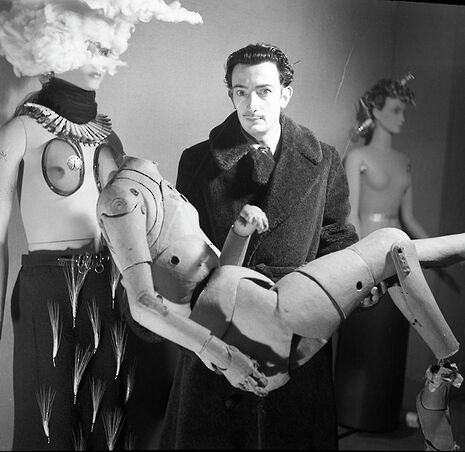Silent Partners
Lavinia Puccetti on the Silent Partners exhibition at the Fitzwilliam Museum and how its mannequins come to life

There is something both dead and alive about a mannequin. They were once used to study light and composition, but mostly for their capability of retaining the subject’s pose indefinitely. The Fitzwilliam’s current exhibition gives voice to these forgotten artist’s tools, and demonstrates the power of human replicas.
In the second room of Silent Partners, Walter Sickert’s lay figure, George, generates the uncanny; a feeling reflected by the photographs of Surrealist mannequins from the 1938 Exposition Internationale du Surréalisme in Paris. Sickert uses George as a corpse-like model wrapped in a shroud to paint The Raising of Lazarus (1929-32). A princely-posed Salvador Dali, in another photograph on display, holds a Surrealist and headless female figure. Both mannequins convey a sense of death, but Dali’s is a step forward towards the vocalisation of the mannequin’s spirit. The headless wooden girl, representing the once passive female body, is embraced by Dali and Surrealism as the vehicle though which she can attain freedom.
Other photographs in the exhibition show different types of lay figures; the fashion mannequin: a bourgeoisie trope, an idealised and stereotyped figure, the banner of consumer culture. The window-shopper would have been allured to buy, just by looking at these presences, these silenced women-an emblem of passivity. The surrealist dressed these fashion mannequins with objects that made them ‘unfamiliar’, almost unpleasant.
The photographs of Masson’s mannequin shows the dummy muted by a green gag while a cage through which goldfish swims encases its head. Birds nest in her armpit and a G-string covers her genitalia. The figure is surrounded by tiger-eyes – an emblem of wisdom. Masson’s mannequin exposes the sadomasochistic repression of women in society. Sicket’s lay figure is silent; Masson, Bellmer and the other surrealist’s mannequins have a strong, hallucinogenic voice.
In Alan Beeton’s Reposing, the mannequin is positioned in a chair in the artist’s studio, much like a model, tired of posing. Sometimes crossing the line between reality and dreams may result in a disturbing confusion.
“Please make it possible that my sense of touch will be able to take pleasure in those parts where the layers of fat and muscle suddenly give way to a sinuous covering of skin.”
Such were the artist Kokoschka’s words when he commissioned a mannequin of his lost lover, Alma Mahler. After having venerated the mannequin for years, Kokoschka beheaded the doll at a party and then proceeded to break a bottle of red wine over its body. This is the only absent mannequin at the Fitzwilliam museum, one which is however present in the form of two exhibited, swiftly executed sketches of the Alma ‘fetish’, drawn in 1919.
‘Who are you?’ is the question Silent Partners asks, and as I look at these pictures of the Surrealist mannequins I find the there is no conclusive answer. Silent Partners: Artist and Mannequin from Punction to Fetish, is open now and runs until the 25th January 2015.
 News / Caius mourns its tree-mendous loss23 December 2025
News / Caius mourns its tree-mendous loss23 December 2025 News / Clare Hall spent over £500k opposing busway 24 December 2025
News / Clare Hall spent over £500k opposing busway 24 December 2025 Comment / The ‘class’ of Cambridge24 December 2025
Comment / The ‘class’ of Cambridge24 December 2025 Comment / Yes, I’m brown – but I have more important things to say22 December 2025
Comment / Yes, I’m brown – but I have more important things to say22 December 2025 Interviews / Politics, your own way: Tilly Middlehurst on speaking out21 December 2025
Interviews / Politics, your own way: Tilly Middlehurst on speaking out21 December 2025







